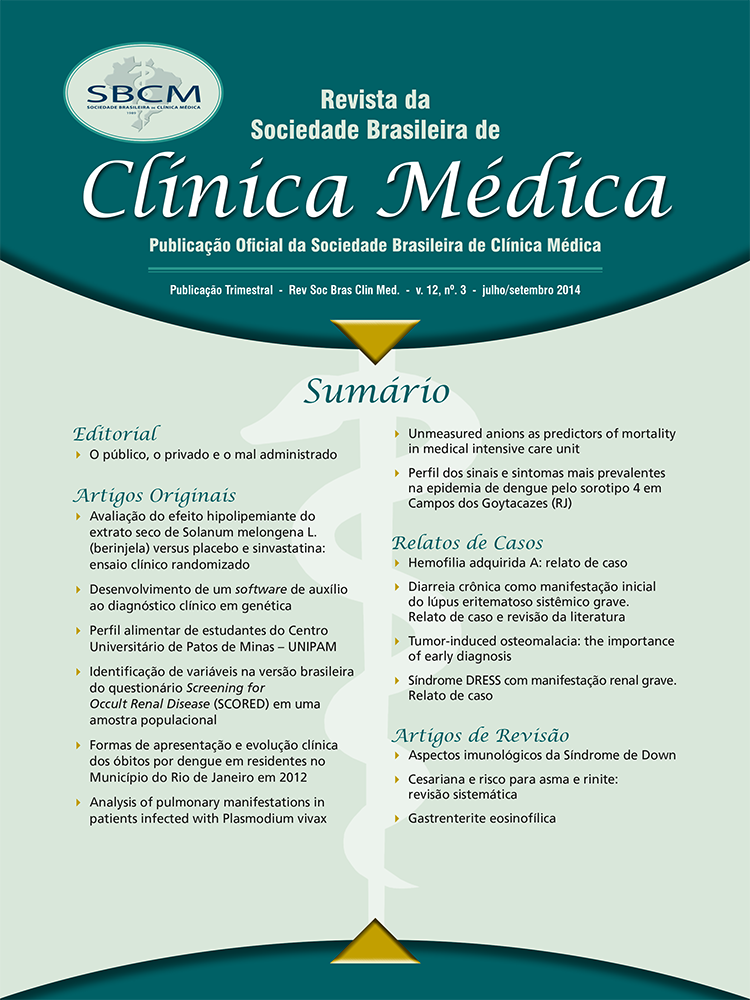Tumor-induced osteomalacia: the importance of early diagnosis
Main Article Content
Resumo
Tumor-induced osteomalacia is a rare paraneoplasic syndrome that can be completely cured with the removal of the culprit tumor. This study described the clinical history of a patient affected by tumor-induced osteomalacia. The patient was a 57-year-old female who sought hospital due to intense and progressive pain in the lower limbs and muscle weakness, as well diffuse osteoporosis and a variety of pathologic fractures at radiographs. Laboratory tests revealed hypophosphatemia with hyperphosphaturia and raised the hypothesis of tumor-induced osteomalacia. Whole-body technetium-99m octreotide scintigraphy revealed the presence of a focal area of radiotracer uptake in the medial region of the left tarsus. After tumor excision, there was a rapid correction of serum phosphorus, reduction of musculoskeletal complaints and evidence of bone healing. Despite the diagnosis and treatment, the patient had an unfavorable clinical outcome; she developed sepsis from pulmonary focus, evolving into refractory septic shock and death. We stress the need for greater recognition of tumor-induced osteomalacia as a cause of clinical bone pain, fractures, osteopenia and muscle weakness, superimposed on the characteristic biochemical profile with hypophosphatemia and relative hyperphosphaturia. Greater awareness of the disease will allow earlier diagnosis and ultimately a greater curative potential for patients afflicted with this syndrome.
Article Details
Declaração de Direito Autoral
Eu (nome do autor responsável) _______________________________________________ declaro que o presente artigo intitulado ___________________________________é original, não tendo sido submetido à publicação em qualquer outro periódico nacional ou internacional, quer seja em parte ou em sua totalidade. Declaro, ainda, que uma vez publicado na revista Revista da Sociedade Brasileira de Clinica Médica, editada pela Sociedade Brasileira de Clínica Médica, o mesmo jamais será submetido por um dos demais co-autores a qualquer outro meio de divulgação científica impressa ou eletrônica.
Por meio deste instrumento, em meu nome e dos demais co-autores, cedo os direitos autorais do referido artigo à Revista da Sociedade Brasileira de Clinica Médica, e declaro estar ciente de que a não observância deste compromisso submeterá o infrator a sanções e penas previstas na Lei de Proteção de Direitos Autorias (n 9610 19 de fevereiro de 1998) que altera, atualiza e consolida a legislação sobre direitos autorais e dá outras providências. Disponível em: http://www.planalto.gov.br/ccivil_03/leis/l9610.htm
|
_________________________ |
___________________ |
|
Local, data |
Assinatura |
SOCIEDADE BRASILEIRA DE CLÍNICA MÉDICA
CNPJ/MF 062.279.617/0001-45
Rua Botucatu, nº 572, cj. 112, São Paulo, SP
Download da Declaração de Direito Autoral.
